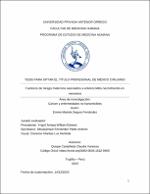Factores de riesgo maternos asociados a enterocolitis necrotizante en neonatos
Resumen
Objetivo: Establecer si existe asociación entre los factores de riesgo maternos y el desarrollo de enterocolitis necrotizante (NEC) en neonatos. Materiales y métodos: Se realizó un estudio observacional analítico retrospectivo de casos y controles para determinar y analizar los factores maternos asociados a NEC en neonatos del servicio de neonatología del Hospital Víctor Lazarte Echegaray (HVLE), en el periodo 2016 – 2023. Se utilizó las historias clínicas de la población ya mencionada, con un tamaño de muestra total de 235 (78 casos, 157 controles) mediante muestreo aleatorio simple (probabilístico).
Resultados: Este estudio muestra una asociación significativa (p < 0.05) entre los factores de riesgo maternos (preeclampsia y antibiótico (ATB) en el III trimestre de embarazo) y el desarrollo de NEC en neonatos. Con respecto a la preeclampsia, se encontró en un 19.2% (15 pacientes) de 78 pacientes con NEC. Y ATB en el III trimestre de embarazo se encontró en un 41% (32 pacientes) de 78 pacientes con NEC. Por lo contrario, los factores de riesgo como hipertensión crónica, diabetes gestacional, sepsis materna, y obesidad materna, no mostraron una asociación significativa con el desarrollo de NEC en neonatos.
De los factores de riesgo intervinientes neonatales, la prematuridad, restricción del crecimiento intrauterino (RCIU) y la sepsis neonatal mostraron una alta probabilidad de asociación a NEC.
Conclusiones: Este estudio demostró que los factores de riesgo maternos, como la preeclampsia y ATB en el III trimestre de embarazo, tienen una asociación estadísticamente significativa con el desarrollo de NEC Objective: To establish whether there is an association between maternal risk factors and the development of necrotizing enterocolitis in neonates.
Materials and methods: An analytical observational retrospective case-control study was carried out to determine and analyze the maternal risk factors associated with NEC. This study was carried out in neonates from the neonatology department of the HVLE, in the period of 2016 - 2023. Medical records of this population were requested and use to gather the data for this research, with a total sample size of 235 (78 cases, 157 controls) through probabilistic simple random sampling
Results: This study shows a significant association (p < 0.05) between maternal risk factors (preeclampsia, ATB in the third trimester of pregnancy) and the development of NEC in neonates. Regarding preeclampsia, it was found in 19.2% (15 patients) of 78 patients with NEC. And ATB in the III trimester of pregnancy was found in 41% (32 patients) of 78 patients with NEC. On the contrary, maternal risk factors such as chronic hypertension, gestational diabetes, maternal sepsis, and maternal obesity did not show a significant association with the development of NEC.
Of the neonatal intervening risk factors, prematurity, intrauterine growth restriction (IUGR) and neonatal sepsis showed a high probability of association with NEC.
Conclusions: This study shows that the maternal risk factors that showed a statistically significant association with NEC were preeclampsia and ATB in the third trimester of pregnancy
Palabras clave
Colecciones
- Medicina Humana [3196]


